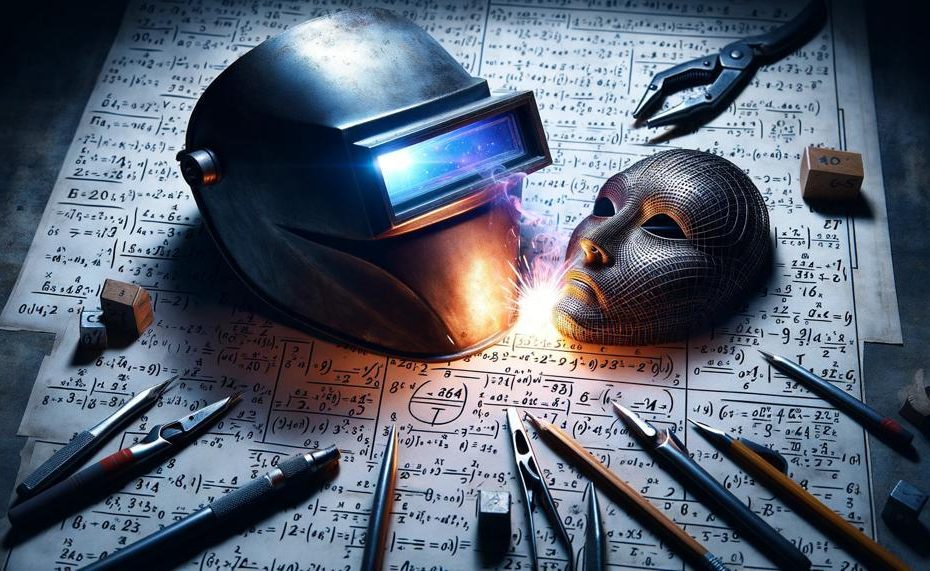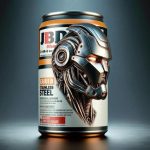Often perceived merely as a hands-on task, welding, in reality, is deeply rooted in mathematical principles. Understanding this could significantly elevate your welding game, transforming good work into great, and great into unparalleled.
In this exploration, we’ll dismantle the myth that welding is all brawn and no brains. We’ll showcase precisely why those seemingly abstract numbers and formulas are your best allies on the shop floor.
So, does welding require math?
Yes, welding requires math. Welders need to be familiar with fractions, decimals, geometry, volume, area, measurements, and trigonometry. Welders also need to understand tangents, signs, and cosigns to test the strength of the joint.
Welders measure materials and areas, so they need to be highly familiar with math. For example, blueprints often have calculations based on fractions that need to be converted to decimals to get accurate weld points. Welders also need to understand, calculate, and measure welds at different angles.
However, some say that the basic arithmetic you learned in high school or for your GED should be enough. Others say that whether you need to be good at math to be a welder depends on the type of welding you plan to do. For example, fabricators will need more math.
Let’s get started.
Contents
- 1 Math Is A Vital Part of Professional Welding
- 2 Arithmetic in Welding
- 3 Fractions and Decimals in Welding
- 4 Geometry in Welding
- 5 Trigonometry in Welding
- 6 Volume and Area in Welding
- 7 Advantages of Knowing Higher Math as a Welder
- 8 How Do I Learn Math for Welding?
- 9 Getting Better at Welding Math
- 10 Knowing Math Is Essential for Welding
- 11 Conclusion
Math Is A Vital Part of Professional Welding
Given the intricacies of professional welding, it’s clear that mathematics is not just an add-on; it’s the backbone that ensures precision, strength, and efficacy in every weld.
The use of math in welding spans from basic measurements to the application of advanced geometrical and trigonometrical concepts, emphasizing its indispensability in this field.
| Concept | Application in Welding | Why It’s Important |
| Measurement | Accurate measuring of materials for cutting and fitting. | Ensures materials fit precisely, reducing waste and ensuring structural integrity. |
| Geometry | Calculating angles, radius, volume, and circumference for joints. | Facilitates the creation of accurate joints that are critical for the weld’s strength. |
| Formulas | Using squared and cubed calculations for determining gas pressure, volume, etc. | Essential for setting correct welding parameters, affecting the quality of the weld. |
| Trigonometry | Calculating angles and the strength of a weld. | Helps in predicting the weld strength and ensuring it meets safety standards. |
| Blueprint Reading | Understanding scales, measurements, and technical drawings. | Crucial for following design specifications accurately to avoid costly mistakes. |
The ability to swiftly convert between fractions and decimals, for example, allows welders to follow measurements on blueprints without error. Meanwhile, grasping the principles of geometry lets them fabricate metal structures that precisely fit together, upholding the integrity and safety of the final product.
Furthermore, welding is not just about joining two pieces of metal; it’s about ensuring these joints can withstand pressures and loads as designed. Here, the knowledge of formulas and trigonometry is invaluable, enabling welders to calculate the necessary angles and the strength of the welds, thereby preventing structural failures.
Also, the interpretation of blueprints – a common language in construction and manufacturing – hinges on a solid understanding of mathematical concepts. These technical documents are filled with numerical data, measurements, and specifications that guide the welding process from start to finish.
Arithmetic in Welding
Welding isn’t just about melting and fusing metals; it’s a craft steeped in mathematical precision, demanding a blend of geometry, trigonometry, basic arithmetic, and metallurgy to ensure each joint is robust, exact, and up to code.
| Concept | Application in Welding | Example |
| Geometry | Interpreting and applying blueprints | Calculating the angle between two pieces of metal to be welded |
| Trigonometry | Calculating angles and lengths | Finding the length of a weld seam on a pipe joint |
| Measurements | Precise cutting and filler application | Measuring the circumference of a pipe to calculate filler metal volume |
| Algebra | Setting welding parameters | Calculating the right voltage and current for the thickness of metal |
| Metallurgy | Choosing the right filler metal | Determining how a metal will expand with heat to avoid stress fractures |
In practice, a welder’s day is filled with calculations: from ensuring a beam’s angle complements the structure it supports, to adjusting the welder’s settings based on the thickness of the metal, every weld is a testament to precision.
Fractions and Decimals in Welding
Understanding and applying fractions and decimals is indispensable in the welding sector. These mathematical concepts underpin numerous daily operations, ensuring accuracy and efficiency in welding tasks.
Vital Applications:
Blueprint Interpretation:
- Welders frequently engage with blueprints that denote measurements in fractions and decimals.
- These blueprints provide critical information for constructing or repairing structures and components with precision.
Measurement and Calculations:
- Exact measurements are paramount in welding to ensure components fit seamlessly and maintain structural integrity.
- Calculations involving fractions and decimals are necessary for determining material dimensions, cutting lengths, and aligning components accurately.
Geometric Comprehensions:
- Welding often necessitates calculating angles, radii, and other geometric parameters, necessitating a firm grasp of fractions and decimals.
Why Mastery Matters:
- Quality Assurance: Precision in measurements and cuts directly correlates with the quality and durability of the welds.
- Efficiency: Proficient use of fractions and decimals minimizes material waste and reduces rework due to measurement errors.
- Problem-solving: Understanding these concepts aids in troubleshooting and adapting to on-site challenges effectively.
| Concept | Application in Welding | Importance |
| Fractions | Interpreting blueprints, measuring materials | Ensures precision and fit |
| Decimals | Calculating dimensions, adjusting settings | Enhances accuracy and efficiency |
| Geometry | Assessing angles, radii | Crucial for structural integrity |
A robust understanding of fractions and decimals propels a welder’s ability to interpret complex blueprints, perform precise measurements, and execute accurate geometrical calculations, making them indispensable in the welding industry.
Geometry in Welding
In the welding world, knowing geometry is like carrying a map. The process of forging connections between metal components is not the only factor that affects the strength and durability of a construction.
Think of geometry as the coded language that welders use to communicate with their craft; it directs each spark and bead precisely.
Table of Welding Geometry Parameters and Their Impact:
| Parameter | Impact on Welding | Considerations |
| Joint Shape | Determines the weld’s load-bearing capacity | Choose the most suitable joint geometry for the intended application |
| Angle of Approach | Affects penetration and weld quality | Adjust angle for optimal fusion between weld and base metals |
| Surface Area | Influences welding time and material consumption | Optimize weld passes to efficiently cover the area |
| Depth of Weld | Impacts the strength and durability of the weld | Ensure adequate penetration without compromising the metal’s integrity |
In essence, mastering the geometry in welding is not just about making two pieces of metal stick together; it’s about crafting a bond that’s as enduring as it is strong. It’s about the finesse in the flame, the dance between depth and angle, and the silent calculation that turns a good weld into a great one.
Trigonometry in Welding
Trigonometry in welding is the compass that guides welders through the complex geography of angles and joints, ensuring that every fusion not just holds but lasts.
It’s the backbone of calculating precise angles for welds that must withstand pressures as varied as the environments they’ll call home. Let’s dive straight into the heart of it:
Understanding the Basics
Trigonometry, with its trio of sine, cosine, and tangent, serves as the welder’s toolkit for navigating the intricate dance of angles and measurements.
These mathematical functions allow welders to pinpoint the exact angles needed for their welds to meet the demands of strength and durability.
Calculating Weld Areas and Angles
Calculating the area of a weld is pivotal for determining the amount of welding material required and for estimating the weld’s strength.
The angle of the weld, on the other hand, is crucial for ensuring that it can handle the specific stresses it will face. Here’s how trigonometry comes into play:
| Function | Application in Welding | Purpose |
| Sine | Calculating opposite side/ hypotenuse | Determining the weld angle relative to a base line |
| Cosine | Calculating adjacent side/ hypotenuse | Identifying the strength and direction of a weld |
| Tangent | Calculating opposite side/ adjacent side | Measuring the slope or grade of a weld seam |
Crafting Enduring Bonds
The precision trigonometry brings to welding isn’t just about adhering to technical specs; it’s about crafting connections that last.
By calculating the optimal angle for a weld, welders ensure that the joint can bear loads and resist stresses, whether it’s the chill of the arctic or the blaze of the desert sun.
Real-world Application
Consider a scenario where a welder must join two beams at a right angle to support a structure. Trigonometry will guide them in calculating the most effective weld path, ensuring the joint is not only strong but also efficient in material use and stress distribution.
Volume and Area in Welding
In the world of welding, volume and area calculations are not just numbers; they are the blueprint for strength, efficiency, and cost-effectiveness.
Understanding how to apply these figures can significantly enhance the quality and durability of welding projects.
Volume Calculations in Welding
Volume calculations play a pivotal role in determining the quantity of filler material required for a weld. This is crucial for ensuring that the joint is sufficiently strong to handle the intended load. Calculating the volume of the filler metal involves measuring the weld joint’s dimensions (length, width, and depth) and applying the formula: V = l × w × h.
This calculation helps welders prepare adequately, ensuring they have enough filler material on hand without overstocking, thus optimizing project costs.
Area Calculations in Welding
Similarly, calculating the area is essential for understanding the weld joint’s surface size. This insight allows welders to adjust their techniques and the amount of heat applied, ensuring that the weld penetrates properly without damaging the surrounding metal.

Different areas may require different welding approaches, and understanding this can be the difference between a mediocre weld and an excellent one.
Welding Efficiency and Quality
The art of welding relies heavily on precision. By using volume and area calculations, welders can significantly reduce material wastage and improve the efficiency of their welding projects.
Moreover, these calculations enable a better understanding of the project scope, facilitating accurate cost estimations that are essential for both large-scale industrial and small-scale personal projects.
Advantages of Knowing Higher Math as a Welder
Welding is not just about joining metals; it’s an art that demands precision and understanding beyond the basics.
Diving into the intricate world of higher math opens up a plethora of opportunities for welders, enhancing their craft to levels unimagined.
| Sharper Precision and Accuracy | Grasping geometry and trigonometry enables welders to map out complex structures with pinpoint accuracy. In realms where the margin for error is slim, such as aerospace or undersea constructions, these skills are indispensable. |
| Optimal Machine Settings | Algebraic prowess comes to play in tweaking welding machine settings. Calculating the perfect balance ensures the right amount of heat and material use, leading to impeccable welds. |
| Enhanced Problem-Solving | Higher math hones a welder’s ability to tackle challenges head-on, with a logical and systematic approach. This skill is crucial in a field where challenges are as frequent as they are varied. |
| Advancement in Techniques | Understanding calculus and physics propels welders into the future of the profession, allowing them to engage in cutting-edge welding techniques that require a deep understanding of heat dynamics and material properties. |
| Quality Assurance | Knowledge in metallurgy and advanced calculations can significantly uplift the quality of welding, ensuring that each project not only looks good but is structurally sound and durable. |
| Career Growth and Opportunities | With a strong foundation in higher math, welders can access prestigious projects in industries demanding precision, such as automotive and aerospace, often leading to better remuneration and job satisfaction. |
| Personal Development | Mastering higher math injects welders with confidence and pride in their craft, fostering a sense of achievement and recognition in their professional circles. |
How Do I Learn Math for Welding?
Welding, at its core, is an art melded with science, demanding not just a steady hand and a keen eye but also a solid grasp of mathematical concepts. The misconception that welding is all brawn and no brains couldn’t be further from the truth.
Let’s dissect the ways to sharpen those mathematical swords, ensuring every weld not only holds strong but stands as a testament to precision and skill.
Hands-on Practice: The Crucible of Learning
Nothing beats the raw experience of hands-on practice. It’s in the sparks of the welder that theory transforms into practical knowledge.
Tackling various projects allows one to navigate through the nuances of measurements and calculations, embedding the principles of angles and proportions into the muscle memory of every welder.
Engaging Courses Tailored for Welders
Embarking on courses specifically crafted for welders opens new avenues of learning. These programmes delve into the essence of basic math, geometry, and trigonometry, illuminating their practical applications in welding.
Whether through the hallowed halls of trade schools or the digital classrooms of the internet, these courses are a beacon for those yearning to master the mathematical dimensions of welding.
| Tool | Use | Benefit |
| Protractors | Measuring Angles | Enhances Accuracy |
| Calipers | Measuring Dimensions | Improves Precision |
| Angle Finders | Determining Exact Angles | Reduces Margin of Error |
Blueprints: The Map to Mastery
Welding blueprints are the compass that guides the welder through the intricate journey of assembling metal pieces. Grasping the ability to decode these blueprints, with their detailed instructions and measurements, is pivotal.
It’s a skill that ensures the creation not just of a structure, but of a masterpiece.
Algebra: The Foundation of Calculations
The realm of welding calculations is built upon the bedrock of algebra. Understanding how to juggle measurements across units and apply formulas for calculating dimensions and angles is what sets a seasoned welder apart from the novices.
It’s the difference between a weld that fits ‘just right’ and one that misses the mark.
The Continuous Quest for Knowledge
Welding, much like any craft, demands perpetual growth. Consistent practice with measurements, calculations, and blueprint reading, paired with the wisdom shared by seasoned welders and the insights gained from workshops, forge a welder ready to face the challenges of tomorrow.
Welding is not just about melting metals together; it’s about fusing precision, skill, and mathematical acumen into every joint.
Getting Better at Welding Math
To finesse one’s craft in welding, a robust grasp of certain mathematical principles is indispensable. Below, we shed light on the fundamental concepts vital for any welder aiming to enhance their expertise.
| Concept | Application in Welding | Importance |
| Measurement | Ensuring precise cuts and alignments | Foundation of accurate welding |
| Fractions/Decimals | Conversion and measurement accuracy | Essential for precise fitting |
| Geometry | Angles, volume, and shape calculation | Crucial for material preparation |
| Trigonometry | Angle and distance calculations | Key for complex structures |
| Blueprint Reading | Interpreting design plans | Vital for project visualization |
| Formulas | Calculating material needs and adjustments | Important for efficient resource use |
A welder’s proficiency in these areas not only boosts their skill set but also significantly enhances the quality and integrity of their work.
Whether it’s calculating the right amount of material, understanding the intricate details of a blueprint, or adjusting welding techniques based on the metal’s properties, these mathematical concepts are invaluable.
Knowing Math Is Essential for Welding
Having a strong understanding of math is crucial for successful welding because it underpins every aspect of the welding process, from preparation to the final execution.
This necessity stems from several key areas where mathematical knowledge is applied directly to achieve precision, efficiency, and safety in welding projects. Let’s delve into the specifics.
Precision in Measurements and Calculations
| Area | Application | Impact |
| Measurements | Accurately measuring materials ensures that cuts and welds are made to exact specifications. | Prevents wastage of material and ensures the welded structure fits together perfectly. |
| Filler Material Calculation | Determining the right amount of filler material for the job. | Ensures weld strength and efficiency, avoiding weak joints or excess use of materials. |
| Expansion/Contraction | Calculating material expansion or contraction due to heat. | Avoids distortion, ensuring the final product retains its intended shape and size. |
Safety and Effectiveness
| Aspect | Application | Impact |
| Electrical Currents | Calculating the correct electrical currents for welding processes. | Ensures safe operation while optimizing the weld quality. |
| Heat Levels | Determining appropriate heat levels based on material properties. | Prevents overheating which can weaken welds or damage materials. |
Cost Efficiency
| Task | Necessity | Benefit |
| Budgeting | Accurate cost estimations for materials and labor. | Helps in pricing projects competitively while ensuring profitability. |
| Resource Management | Efficient use of resources based on precise calculations. | Avoids wastage and reduces costs, contributing to a more sustainable practice. |
Structural Integrity
Understanding how to calculate the strength of a weld based on its cross-sectional area is vital.
It informs the welder if the joint can handle the stress it’s expected to endure, ensuring the longevity and safety of the structure.
Conclusion
Discovering how numerical accuracy drives the artistry of welding may be intriguing when one looks at the relationship between mathematics and welding. By following the extensive journey outlined in “Unlocking the Equation: How Math Powers the Art of Welding,” we have discovered the crucial role math plays in every aspect of welding, from figuring out material usage to optimizing heat and power settings, from comprehending joint geometry to mastering measurements for execution. This investigation debunks the misconception that welding is just a physically demanding activity by emphasizing the mathematical underpinning of the trade.
Welding is a complex precise dance in which the welder uses angles, measurements, and computations to direct their hand in order to ensure strength, efficiency, and better aesthetics. It is not just about connecting metals. From simple arithmetic to intricate trigonometry and geometry, mathematics has a wide range of applications in welding. It is the silent companion in the welder’s workshop, guaranteeing that every fusion is not only strong but also well suited for its intended use.
As we’ve seen, having a solid understanding of arithmetic helps welders convert abstract numbers into tangible outcomes, allowing them to create welds that maximize structural integrity and adhere to strict safety regulations while reducing waste. This exploration of the mathematical terrain of welding highlights the crucial collaboration between the accuracy of mathematical principles and the welder’s expertise, illuminating the route to greatness in welding.





